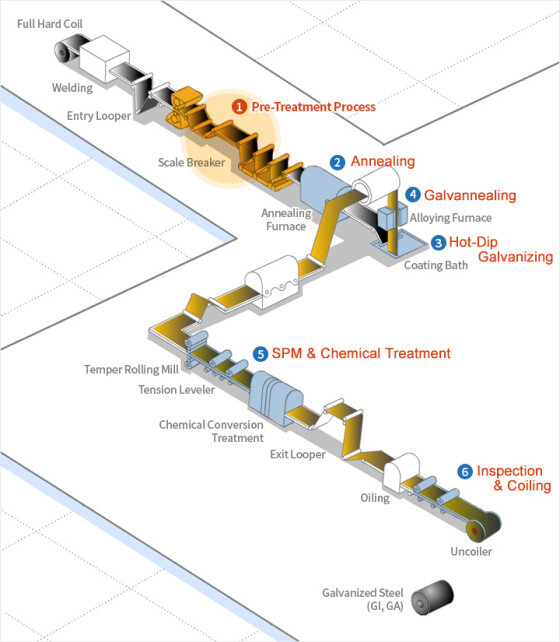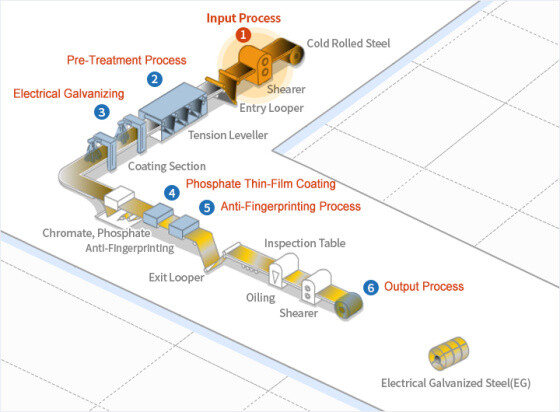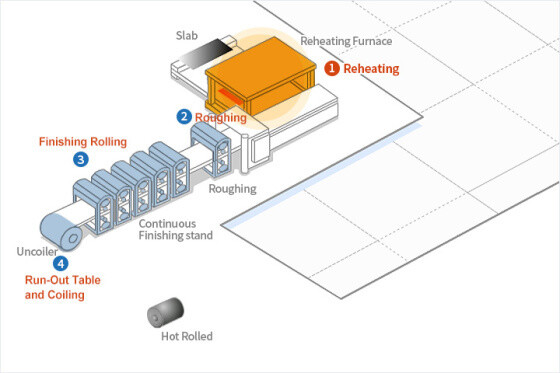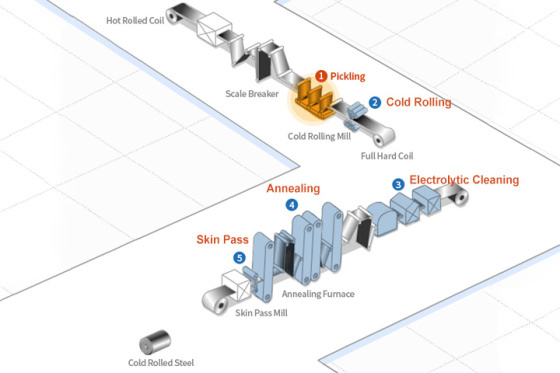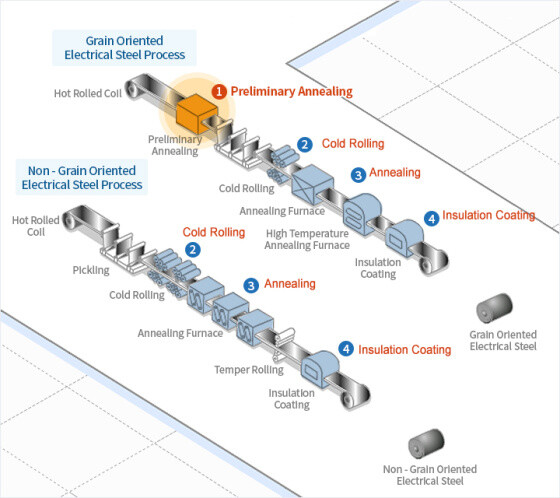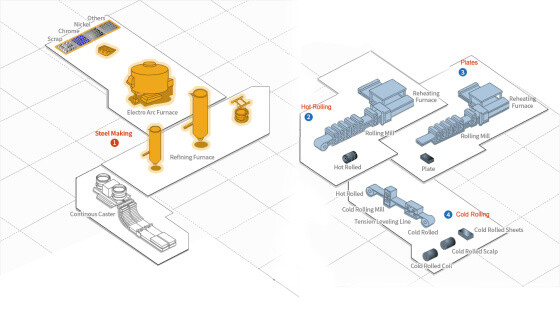
Processo de fabricação
 Galvanized SteelGalvanized Steel
Galvanized SteelGalvanized Steel1. Pre-Treatment Process: Some rolling oil and other contaminants remain on the surface of cold rolled steel sheets following processing. These are removed by passing the electrically charged sheet through an alkaline solution which induces an electrochemical reaction.
2. Annealing: The material properties of the pre-treated steel sheet can be altered and improved through recrystallization during the annealing process.
3. Hot-Dip Galvanizing: After passing through the annealing furnace, steel sheets are dipped into a zinc pot where molten Zn is coated onto the surface. The desired coating weight is achieved by removing excess zinc before solidification with high-pressure air from an air knife.
4. Galvannealing: The surface of a steel sheet, after the air knife, can be coated with a zinc compound prior to reheating in an annealing process. Zn atoms diffuse into the Fe to create a Zn-Fe series alloy.
5. SPM & Chemical Treatment: In order to achieve a flat surface and an elegant finish, the steel sheet is processed with a skin pass mill. In order to prevent the white rust, which often forms on the surface of activated zinc, and to improve corrosion resistance, the surface is coated with a Cr-free resin.
6. lnspection & Coiling: In order to achieve a flat surface and an elegant finish, the steel sheet is processed with a skin pass mill. In order to prevent the white rust, which often forms on the surface of activated zinc, and to improve corrosion resistance, the surface is coated with a Cr-free resin.Saiba mais → Electrical Galvanized SteelElectrical Galvanized Steel
Electrical Galvanized SteelElectrical Galvanized Steel1. lnput Process: Equipment at the entry point of the electrogalvanizing line consists of a pay-off reel, a shearing M/C, a welding M/C, a looper and a tension leveler. The pay-off reel transports stacked or cold rolled steel materials to the shearing machine which cuts and connects them in preparation for welding. Then comes the welding.
2. Pre-Treatment Process: An electrolytic cleaning line consists of an electrolysis tank, an acid bath and a rinse tank to remove contaminants and oxide films from the surface of the steel before electroplating.
3. Electrical Galvanizing: The CAROSEL method, among other electric galvanizing, involves the plating of one side at a time by means of a conductor roll. This process produces two-sided, single-sided, differential-sided plated sheets. There is also the horizontal type where two sides of a sheet are plated at the same time to produce a two-sided plated sheet.
4. Phosphate Thin-Film Coating: A phosphate thin-film is applied to the surface of the zinc layer through chemical or electrochemical reactions. The film is intended to provide temporary anti-corrosion protection and to generate a secure painting substrate.
5. Anti-Fingerprinting Process: An organic, inorganic or organic-inorganic hybrid film is applied to the surface of sheet steel in order to supplement its corrosion resistance and to enhance desirable properties such as resistance to fingerprint marks and workability.
6. Output Process: The exit point of the line includes an output looper, tension reel, and an automatic packaging line to protect the products after coil winding.Saiba mais → Hot Rolled Steel
Hot Rolled SteelHot Rolled Steel
1. Reheating: Hot rolled coils pass through a pickling line, where scale breaker machines and hydrochloric acid solutions are used to remove any surface scale and/or oxide film that which causes surface flaws during the final stage of cold rolled steel processing.
2. Roughing: In this process, slabs whose surface scale share has been removed are made into rolled materials with the proper shape, thickness, and width. In the entry and exit area of the roughing mill, an edger rolls the strip in the width direction using an Automatic Width Control (AWC) system.
3. Finishing Rolling: The purpose of finishing rolling is to adjust the thickness and width of a coil to the specified dimensions and to produce a smooth surface and shape at the desired finishing temperature appropriate for its intended use. Our up-to-date equipment, including Work Roll Shift Mills, Pair Cross Mills and On-line Roll Grinders (ORG), enhances plant productivity and improves the quality of the finished coils by controlling the crown shape.
4. Run-Out Table and Coiling: Steel strips, after the finishing mill, are passed to the run-out table where they are coiled. While being rolled on the table, the strips are sprayed with water to cool them to the proper temperature for coiling.Saiba mais → Cold Rolled Steel
Cold Rolled SteelCold Rolled Steel
1. Pickling: Hot rolled coils pass through a pickling line, where scale breaker machines and hydrochloric acid solutions are used to remove any surface scale and/or oxide film that which causes surface flaws during the final stage of cold rolled steel processing.
2. Cold Rolling: Pickled coils are cold rolled in tandem mills to a specified thickness, typically 40 to 90%, of original material dimensions. Fully automated shape adjustment is ensured through state of the art process machinery.
3. Electrolytic Cleaning: The purpose of electrolytic cleaning is to remove lubricant oil and contaminants on the cold rolled steel prior to the annealing process.
4. Annealing: This is a highly productive manufacturing method whereby steel products with extra deep drawing qualities and high tensile strength can be produced. Two annealing methods are commonly used: batch annealing and continuous annealing.
5. Skin Pass: This final rolling process is performed in order to remove minor surface defects such as stretch marks and to produce a smooth, lustrous surface. Skin Pass results in a further thickness reduction of about 1%.Saiba mais → Electrical SteelElectrical steel
Electrical SteelElectrical steel1. Preliminary Annealing: During the preliminary annealing process, a scale which may have formed on the hot rolled steel is removed as delayed passing through scale breaker and a hydrochloric acid bath. This initial heat treatment process improves the cold rolling properties of steel as well as its magnetic properties.
2. Cold Rolling: In order to obtain specific thickness and material properties, a reduction ratio of 40-90% is applied normally. Rolling and edge trimming machines are automatically controlled to obtain uniform thickness and width.
3. Annealing: Annealing is a process in which cold rolled structures are converted to a recrystallized structure through heat treatment. For grain oriented electrical steel, two different annealing methods are available: decarbonization annealing and high-temperature annealing. Decarbonization annealing removes excess carbon from the steel and applies a MgO coating. High-temperature annealing produces secondary recrystallized structures having superior magnetic properties.
4. Insulation Coating: In this process, insulation coating is applied by a continuous coater roll in order to minimize eddy current losses, which are proportional to the sheet thickness. A series of coaters are used to apply insulation coating liquid to the top and bottom of a plate. Grain oriented electrical steel has two layers of coating, a base coating of dark brown Forsterite (Mg2SiO4) as the main ingredient and a transparent insulating coating containing phosphates. For non-oriented electrical steel, various coating methods with various thicknesses and ingredients are used depending on end usage and specific user’s requirements.Saiba mais → Stainless SteelStainless Steel
Stainless SteelStainless Steel1. Steel Making: Steelmaking has the greatest impact on the quality and cost of steel products. We has state-of-the-art AOD, VOD and continuous casting facilities..
2. Hot Rolling: Slabs made in the steelmaking plant are rolled into black coils of highly refined thickness and shape before being made into white coils to the needs of customers through heat treatment, pickling and finishing in the annealing and pickling plant. White coils so produced are used for cold rolling, pipes and sheets.
3. Plates: Slabs produced at the steelmaking plant undergo rolling, heat-treatment and a pickling process, which are then cut into sizes as ordered and delivered to the customer. Thick plates are used by the heavy chemical industries that require corrosion resistance, such as petrochemicals, power plant facilities, paper manufacturing and special shipbuilding.
4.Cold Rolling: JIUZHOU is equipped with 20 high cluster mills, bright annealing line, TLL (Tension Leveling Line), AFC (Automatic Flatness Control), AGC (Automatic Gauge Control), which enable the production of cold rolled products of 0.1-3.0mm in thickness and up to 1580mm in width in various shapes and surface treatment.Saiba mais →

Deixe uma mensagem
Se você estiver interessado em nossos produtos e quiser saber mais detalhes, deixe uma mensagem aqui, responderemos o mais breve possível.

